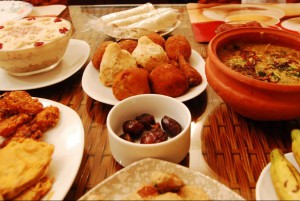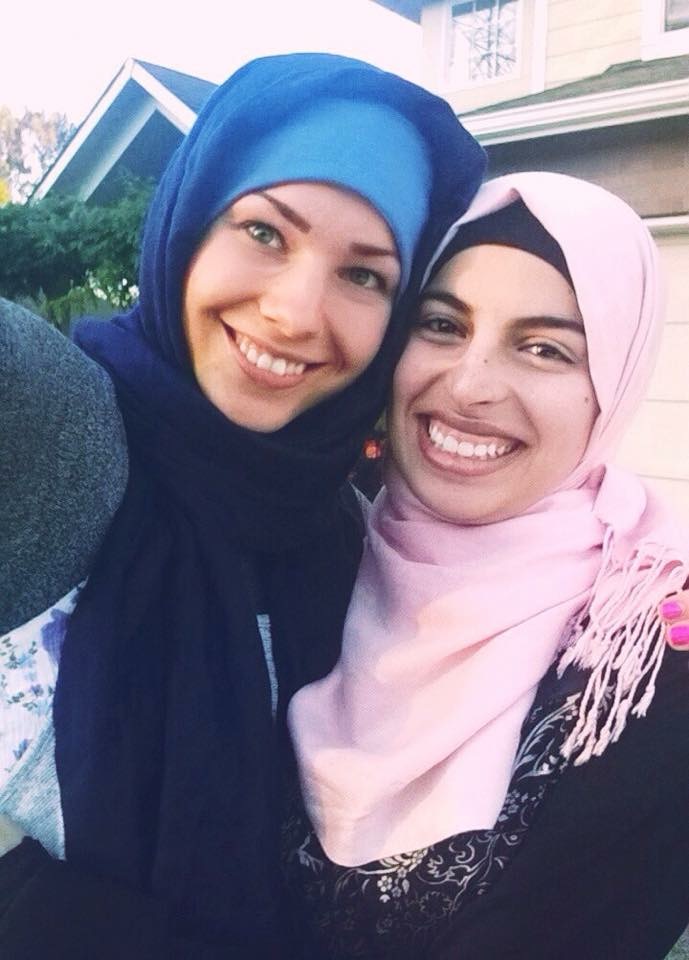By Kseniya Sovenko
Fall 2015 Kaplan Award Winner

The phone buzzed.
“Make sure you eat until 3 a.m.,” read a message on the illuminated Nokia screen.
“After that, no food or water. Dinner will be at 9:12 p.m.”
Most people stay up until 3 a.m., but I’m a newcomer to this practice. That evening, I ate a whole pizza before falling into bed at midnight. Setting an alarm for 2:50 a.m., I interrupted my sleep to quickly chug four cups of water, swallow a peach and timidly rummage through my full-stocked fridge. This was my first time fasting, and I had 18 hours and 12 minutes to go.
Throughout the night, cottonmouth persistently tugged me out of my dreams. The self-imposed limitation on water did little but inspire more thirst.
No wonder Ramadan means “dryness” or “scorching heat.” How does anyone survive fasting from dawn to sundown for a whole month? Somehow, nearly a quarter of the global population does. I imagined fasting in the midst of Middle Eastern, Indian or Indonesian heat—suddenly, tolerating the Seattle heatwave seemed possible.
Working as a journalist, news stories saturated with negative portrayals of Islam began to test my patience. Yet, growing up, a sort of culturally-constructed dissonance hummed in the back of my mind—am I not supposed to be afraid of people like my longtime friend Dana? Thirteen years ago, Dana was the first true friend I made in America.

Despite years of watching Dana boycott school lunches and the lure of our high school’s urinal-shaped water fountains, I never thought to fast myself. I am not Muslim; I am not Christian; I am not Jewish; I am not anything—curiosity is my religion.

Suddenly, it became very important for me to fast, to attend a mosque, to grasp at even an essence of what she experiences.
Fasting is intended to remind practicing Muslims of the challenges faced by those less fortunate and bring them closer to Allah. Ramadan is a time to focus on charity and prayer, end bad habits, increase study of the Qur’an and practice self-restraint.
Able-bodied Muslims are expected to fast during the hours of daylight—sawm is one of the Five Pillars of Islam. Though fasting isn’t expected until puberty, most children begin fasting in at least some capacity prior to adolescence.
During my own fast, I naively thought thirst would remain my greatest challenge. Then came the first pangs of hunger.
By 3 p.m., my appetite was crippling. I could feel the empty crevasses of my stomach churning acid, yearning for a little slice of sustenance. The walls of my throat still longed for a drop of water.
My standard three-hour dance practice only exhausted my efforts. Running out of distractions, my eyes began to wage war with my mind. Look at the clock, don’t look at the clock; study the bubbles forming in the water cooler, avoid them at all costs. The war continued for several hours until, finally, the tyrannizing hands of my watch became my liberators. Sunset was fast approaching.
Wearing a black, floor-length dress and a baby-pink hijab, Dana greeted me with a warm embrace and her usual glowing smile. For her, hijab is modesty in all aspects of the word. For me, she is beauty in all aspects of the word.
That night, she took me to my first community iftar, a shared evening meal during which Muslims break their daily Ramadan fast.
Every Friday, Saturday and Sunday during Ramadan, the ninth month of the Islamic lunar calendar, the Muslim Association of Puget Sound (MAPS) hosts a free, themed community dinner that is open to all. This year, Ramadan began on June 17 and will continue until July 17, the day of Eid al-Fitr.
Before driving to MAPS in Redmond, Dana helped me put on a navy-blue hijab in a “loose-style.”
“Can I pull this off?” I asked.
“You could maybe pass off as Afghan or Pakistani, but you’re still really white so it makes it hard to pinpoint where you’re from,” she said, while looking at her younger sister and laughing. Dana always thought she was born with a funny bone.
By the time we arrived at MAPS, hunger and thirst faded from the forefront of my mind, replaced instead by curiosity and awe. Upon entering the prayer room, I was plunged into a sea of color. The women wore hijabs of every print and hue—scarves with butterflies, scarves with cheetah prints, scarves with rhinestone patterns. Canary yellows, plaids, bright pinks, florals and gold embroidery infused the room with a sort of magic. I felt lackluster in comparison.
My calluses gripped at the plush red and gold carpets beneath my feet—shoes are not allowed in the prayer room. Dozens of little feet playfully ran across the carpets’ repeated motifs as I studied them. Pointing magnetic north, towards Ka’ba in Mecca, the rugs seemed strangely crooked at first sight. During prayer, they help orient Muslims towards Islam’s most important holy site.
The floor on the left side of the gymnasium, partially dedicated to youth basketball, is covered in an IKEA-blue tarp and rows of brown paper. Scattered across them are unopened water bottles and paper plates with dates, samosas and dipping sauces.
When the sun set, my stomach no longer felt empty, my throat no longer parched. I was one of the hundreds listening to the call to prayer, which was interrupted only by the gleeful squeals of young children. Eager hands reached for dates and sips of water to break the daily fast, as the Prophet Muhammad was believed to have done.
“The only dates I get are in Ramadan,” said Dana, accentuating her joke with a signature laugh. The funny bone is always at work.
Even though I had forgotten my hunger, that date was undoubtedly the sweetest I’ve ever had. The sweetness of its flesh lingered on my tongue minutes after my first bite. My first sip of water was equally glorious; though I’ve drunk bottled water thousands of times, I was convinced that particular bottle contained the freshest water of all.
After we ate our samosas, the spiciness of which flooded my stomach with warmth, Dana left me to join the other women facing the ornamental, black-and-white Mihrab to begin her evening prayer. A partial partition separated the men, who are in front, from the women, who are in the back. Because MAPS is a more liberal mosque, Dana explained, the partition only separates half the praying area; the men pray in front so they don’t see the women bend over.
As the men and women prayed and kneeled to the ground, the colors of hijabs and bright shirts floated in and out of the rows of bodies like structured choreography. The harmony of their movements reminded me of waves in the ocean, with only a few heads bopping out of unison to create choppy water. Voices, each quiet on their own, thundered in perfect synergy as they followed the cues of the leading imam.
Upon the end of prayer, a group of hungry, young boys sprinted towards the food, having strategically chosen spots closest to the buffet-style tables. Long lines formed as the air became saturated with the smell of cooked chicken flesh. I suddenly realized that I was one hungry vegetarian.
“My siblings and I would torture ourselves by watching the Food Network during the day,” mentioned Dana as we waited in one of the lines. Afterwards, we shared a dinner of watermelon, salad, rice, pasta, pita bread and veggies in curry.
Sitting on the ground with our full, steaming plates, Dana pulled out extra napkins, nectarines, yogurt and quesadillas from her Microsoft company store bag. She’s prepared for everything. It’s her job, she said.
As our tongues played with the flavors of food, a group of young kids hijacked the main microphone, generating loud feedback in their attempts to broadcast a series of silly sounds. They quickly ran away, rolled on the carpet and exploded in laughter, tears in their eyes.
“They think they’re comedy gold,” scoffed Dana, playfully. Nobody one-ups her.
During my two hours at the mosque, I felt nothing but welcomed. Despite being an outsider, I received zero estranged looks or signs of unfriendliness. After dinner, we were approached by a seemingly shy girl, who spoke to Dana and hid behind a smile before addressing me directly.
“So is this your first time here?” asked the 8-year-old Egyptian girl with a pixie voice, dressed in a black scarf and thobe—traditional clothing for Arabs. Her big, brown eyes are framed with long, matted lashes and her teeth separated by endearing gaps.
“Yes,” I replied, with a smile.
“Oh…” she said, clearly surprised. Her eyes suddenly widened. “I see.”
“Is it hard to be a journalist?” the pixie-voiced girl asked, after a few seconds of silence.
“Yes, it’s really hard.”
“Well it better be!” she exclaimed, raising her eyebrows with effortless sass.
Our laughs echoed off the walls as the pixie-voiced girl sipped on her Frappuccino and a man stood in front of a microphone seeking the owner of a lost iPhone 6.
So this is what America is afraid of.
Originally published in The Seattle Globalist.
